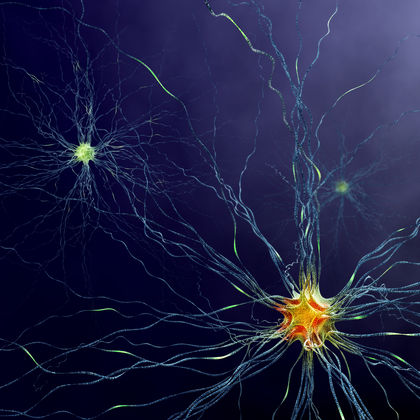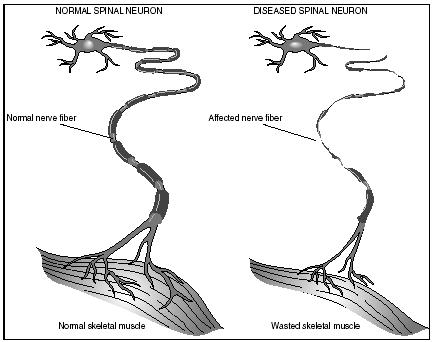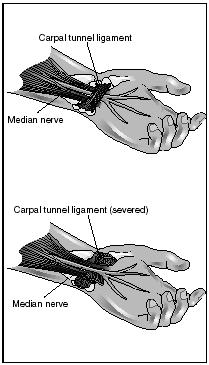The Nervous System - Ailments: what can go wrong with the nervous system?

Because of its role as the master controller of the body, when the nervous system becomes disabled, so does the rest of the body. Injuries to the brain and spinal cord can easily occur in contact sports (such as football, hockey, and boxing) and as a result of falls or collisions in other activities (such as bicycling, horseback riding, skiing, and soccer). They may range from mild concussions where the brain is jarred against the skull, resulting in the temporary slight loss of higher mental functions, to severe spinal injuries where the spinal cord is pinch or severed, resulting in permanent paralysis or even death.
The nervous system can be also adversely affected by diseases or disorders. Some may be genetic (hereditary), others caused by an illness or disease. The following are just a few of the many diseases and disorders that can affect this system or its parts.
Alzheimer's disease (ALTS-hi-merz): Disease of the nervous system marked by a deterioration of memory, thinking, and reasoning.
Amyotrophic lateral sclerosis (a-me-o-TROW-fik LA-ter-al skle-ROW-sis): Also known as Lou Gehrig's disease, a disease that breaks down motor neurons, resulting in the loss of the ability to move any of the muscles in the body.
Carpal tunnel syndrome (CAR-pal TUN-nel SIN-drome): Disorder caused by the compression at the wrist of the median nerve supplying the hand, causing numbness and tingling.
Epilepsy (EP-eh-lep-see): Disorder of the nervous system marked by seizures that often involve convulsions or the loss of consciousness.
Huntington's disease: Inherited, progressive disease causing uncontrollable physical movements and mental deterioration.
Migraine (MY-grain): A particularly intense form of headache.
Parkinson's disease: Progressive disease in which cells in one of the movement-control centers of the brain begin to die, resulting in a loss of control over speech and head and body movements.
Poliomyelitis (po-lee-o-my-eh-LIE-tis): Contagious viral disease that can cause damage to the central nervous system, resulting in paralysis and loss of muscle tissue.
Alzheimer's disease
Alzheimer's disease (AD) is a progressive (tending to grow worse) neurological disorder that results in dementia—impaired memory, thinking, and reasoning. AD usually occurs in old age. It affects approximately 4 million people in the United States and is the fourth leading cause of death among adults (after heart disease, cancer, and stroke). Scientists believe that 5 to 10 percent of people over the age of sixty-five suffer from some form of the disease. AD affects men and women almost equally.
The primary symptoms of AD are the gradual loss of memory, lessened ability to perform routine tasks, disorientation, difficulty in learning, loss of language skills, impairment of judgment and planning, and mood or behavioral changes. Depression, paranoia, and delusions may also arise. The disease begins slowly and gradually. Most people die within eight years after being diagnosed with AD. Some die within a year, while others may live as long as twenty years.
Scientists do not know the exact cause or causes of AD. Research has shown that in people with AD, the centers of the brain concerned with learning, reasoning, and memory become clogged with abnormal tissue. What triggers this twisted mass of tissue to form is, again, unknown.
There is currently no cure for AD. Treatments, however, are available to alleviate or lessen some of the symptoms. Two drugs that have been approved by the U.S. Food and Drug Administration both increase the levels of the neurotransmitter acetylcholine in the brain. This helps increase the communication ability of the remaining neurons, thereby modestly increasing a person's ability to perform normal daily activities. Research into this disabling disease continues.
Amyotrophic lateral sclerosis
Amyotrophic lateral sclerosis (ALS) is a disease that breaks down tissues in the nervous system, affecting the nerves that control body movement. ALS is also known as motor neuron disease and Lou Gehrig's disease, after the American baseball player (1903–1941) whose career it ended.
The disease affects approximately 30,000 people in the United States. It usually begins between the ages of forty and seventy, although it can begin at a younger age. Men are slightly more likely to develop ALS than women. Eighty percent of those people affected with the disease die within five years. However, noted English theoretical physicist Stephen Hawking (1942– ) has lived with ALS for over thirty years.
Technically, ALS causes the destruction of motor neurons that control voluntary muscle movement. For yet unknown reasons, the motor neurons in the spinal cord and brain die. As they die, the muscles they normally control cannot be moved as effectively and begin to waste away. The ability to move virtually any of the muscles in the body is soon lost. ALS principally affects the muscles controlled by conscious thought, such as those in the arms, legs, and trunk.
Weakness in the arms and legs, usually more pronounced on one side than the other, is the earliest symptom of ALS. Later symptoms include the loss of the ability to walk, to use the arms and hands, to speak clearly or at all, to swallow, and to hold the head up. Lung infection, brought on by poor swallowing and the weakness of respiratory muscles, is often the cause of death.
There is currently no cure for ALS, and no treatment that can significantly alter its course.
Carpal tunnel syndrome
Carpal tunnel syndrome is a condition in which the squeezing or compression of the median nerve that passes through the wrist results in numbness,

tingling, weakness, or pain in one or both hands. The hands may become so weakened that opening jars or grasping objects becomes difficult and painful. Women between the ages of thirty and sixty have the highest rates of carpal tunnel syndrome.
The carpal tunnel is a space formed by the carpal (wrist) bones and the carpal ligament (a connective tissue that attaches bone to bone). Through this space pass the median nerve and tendons of the fingers and thumb (the median nerve runs from the neck through the middle of the arm to the fingers). When the tendons within the carpal tunnel become inflamed, they swell and press on the median nerve.
Most often, performing a job that requires repeated bending or twisting of the wrists increases the likelihood of developing the disorder. Continuous flexing of the wrist, as when typing on a keyboard or playing a piano, can cause compression of the median nerve. A number of other conditions can also cause swelling of the carpal tunnel and pressure on the median nerve. Such conditions include pregnancy, arthritis, hypothyroidism (reduced function of the thyroid gland), diabetes, menopause (the point in a woman's life when menstruation ceases and childbearing is no longer possible), and pituitary gland abnormalities.
Carpal tunnel syndrome is treated initially by applying a brace or splint, to prevent the wrist from bending and to relieve pressure on the median nerve. If a person's job is causing the disorder, performing other work may be necessary. Treatment of a related medical condition may relieve the symptoms of carpal tunnel syndrome. Severe cases may require surgery to decrease compression of the median nerve.

Epilepsy
Epilepsy comes from the Greek word for seizure. A seizure is a sudden disruption in the brain's normal electrical activity accompanied by a state of altered consciousness. Epilepsy is a condition characterized by recurrent seizures during which a person may lose consciousness and experience convulsions, or violent repetitive muscle contractions. Scientists believe epilepsy affects 1 to 2 percent of the population of the United States. One in every two cases develops before the age of twenty-five.
The repeated symptoms associated with epilepsy are the result of unusually large electrical charges from neurons in a particular area of the brain. However, the reason this occurs in 50 to 70 percent of all cases of epilepsy is unknown. Epilepsy is sometimes the result of trauma at the time of birth, such as insufficient oxygen to the brain or head injury. Other causes of the disorder may be head injury resulting from a car accident, alcoholism, inflammation of the meninges, infectious diseases such as measles or mumps, or lead or mercury poisoning.
The best known examples of epilepsy are grand mal and petit mal. The term mal comes from the French word meaning "illness," while grand and petit refer respectively to "large" and "small" episodes of the illness.
In the case of grand mal, an epileptic (person suffering from epilepsy) is likely to have some indication (such as a distinctive smell, taste, or other unusual sensation) that a seizure is imminent. This feeling is called an aura. Very soon after feeling the aura, the person will lapse into unconsciousness and experience generalized muscle contractions that may distort the body. The thrashing movements of the limbs that follow are caused by opposing sets of muscles alternately contracting. The person may also lose control of the bladder and or bowels. When the seizures stop, usually after three to five minutes, the person may remain unconscious for up to half an hour. Upon awakening, the person may not remember having had a seizure and may be confused for a time.
In contrast to the grand mal seizure, the petit mal may seem insignificant. The person interrupts whatever he or she is doing and for up to about 20 seconds may show subtle outward signs, such as blinking of the eyes, staring into space, or pausing in conversation. After the seizure has ended, the person resumes his or her previous activity, usually totally unaware that an interruption has taken place. Petit mal seizures generally begin at the age of four and stop by the time a child has become an adolescent. Untreated, petit mal seizures can recur as many as 100 times a day and may progress to grand mal seizures.
Epilepsy is a recurrent, lifelong condition that must be managed on a long-term basis. A number of drugs are available to help eliminate seizures or make the symptoms less frequent and less severe. About 85 percent of all seizure disorders can be partially or completely controlled if an epileptic person takes anti-seizure medications according to directions, gets enough sleep, and eats balanced meals.
Huntington's disease
Huntington's disease (HD) is an inherited, progressive (tending to grow worse) disease that causes uncontrollable physical movements and mental deterioration. It is occasionally referred to as Woody Guthrie's disease, after the American folk singer (1912–1967) who died from it. Approximately 30,000 people in the United States are affected by HD.

American pediatric neurosurgeon Benjamin Carson (1951– ) has undertaken many high-risk operations on children involving complex and delicate neurosurgical procedures. In 1987 he gained international acclaim for leading a team of seventy medical personnel that separated a pair of Siamese twins (children who are born physically connected) who were joined at the backs of their heads.
One of Carson's most difficult operations took place in 1985 when he operated on a four-yearold boy with a malignant tumor of the brain stem (a malignant tumor is one that spreads and causes physical harm). Other physicians had stated that the cancer could not be removed with surgery, but Carson disagreed and went ahead with the operation. The boy eventually made a complete recovery.
Another notable operation involved a four-year-old girl who suffered from multiple seizures—up to 120 a day. Her right side was paralyzed, and she had a rare brain disease that, if unchecked, would have left her with serious neurological damage. Carson removed the diseased left hemisphere of her brain during a ten-hour operation. Six months later she had regained nearly complete use of her right arm and leg and was free of seizures. The right side of her brain had taken over functions of the left.
Carson's most famous medical operation occurred in 1987, when he led a team of doctors, nurses, and technicians to separate a pair of German Siamese twins who shared a blood vessel in the back of their heads. Carson devised a plan to separate the twins by completely shutting down their blood flow, severing their common blood vessel, and then restoring their individual vessel systems. While the entire procedure lasted twenty-two hours, Carson and another surgeon had only one hour to conduct the actual surgery and restoration. The operation went smoothly until Carson noticed the vessels that carried blood from the brain of each child were more tangled than had been expected. Twenty minutes after stopping the twins' circulation, Carson made the final cut. He then had forty minutes to reconstruct the severed blood vessels and close. Just a few minutes before the hour limit, the twins were separated and the operating tables were wheeled apart.
The symptoms of HD usually appear in people between the ages of thirty and fifty. They fall into three categories: motor or movement symptoms, personality and behavioral changes, and mental decline. Early motor symptoms include restlessness, twitching, and a desire to move about. As the disease progresses, a person may experience involuntary jerking or twisting, difficulty in speaking and swallowing, impaired balance, depression, anxiety, the inability to plan and carry out routine tasks, slowed thought, and impaired or inappropriate judgment.
In 1993, scientists discovered the exact gene that causes HD. The gene makes a protein. When the gene is defective, the protein it creates interacts with other proteins in brain cells where it occurs, and this interaction ultimately leads to cell death. A parent, either the mother or father, who has the defective gene has a 50 percent chance of passing it on to his or her children. Male and females are affected equally.
There is no cure for HD and no treatment that can slow its rate of progression. Drugs and physical therapy can help reduce the effects of involuntary muscular movements and mental deterioration. Death usually occurs fifteen to twenty years after a person has been diagnosed with the disease.
Migraine
Migraine is a particularly intense form of headache lasting several hours or more. The term does not apply to a single medical condition, but is applied to a variety of symptoms that are often numerous and changeable. Migraine sufferers find that their headaches are provoked by a particular stimulus, such as stress, loud noises, missed meals, or eating particular foods.
Migraines affect as many as 24 million people in the United States. Approximately 18 percent of women and 6 percent of men experience at least one migraine attack per year. Migraines often begin in adolescence, but are rare after the age of sixty.
A migraine condition can generally be divided into four distinct phases. The first phase is known as the prodrome. Symptoms develop slowly over a twenty-four-hour period; they include feelings of heightened or dulled perception, irritability or withdrawal, and cravings for certain foods.
The second phase, known as the aura, is marked by visual disturbances. These are described as flashing lights, shimmering zigzag lines, spotty vision, and other disturbances in one or both eyes. Other symptoms such as tingling or numbness in the hands may occur as well. All these symptoms can be acutely distressing to the patient. This phase usually precedes the actual headache by one hour or less.
Phase three consists of the headache itself, usually described as a severe throbbing or pulsating pain on one or both sides of the head. It may be accompanied by nausea and vomiting. Light, noise, and movement may worsen the condition. This phase may last from four to seventy-two hours.
During the final phase, called the postdrome, the person often feels drained and washed-out. This feeling generally subsides within twenty-four hours.
Migraine appears to involve changes in the patterns of blood circulation and of nerve transmissions in the brain. Scientists currently believe that migraines develop in three phases. The first step takes place in the midbrain. For reasons not fully understood, cells that are otherwise functioning normally in this region begin sending abnormal electrical signals to other brain centers, including the visual cortex. The second step occurs when blood vessels in the brain dilate (expand), increasing blood flow. The third step occurs when nerve cells that control the sensation of pain in the head and face become activated. The pain of migraine is thought to result from this combination of increased pain sensitivity, tissue and blood vessel swelling, and inflammation.
Several drugs may be used to reduce the pain and severity of a migraine attack. Research has shown that a combination of acetaminophen (Tylenol), aspirin, and caffeine can effectively relieve symptoms for many migraine sufferers. Research has also shown a connection between migraine and low levels of serotonin, a neurotransmitter found in the brain. Drugs that chemically resemble serotonin have proven effective in treating migraine.
Parkinson's disease
Parkinson's disease (PD) is a progressive (tending to grow worse) disease in which cells in one of the movement-control centers of the brain begin to die. Nerves and muscles become weak, and the control over speech and head and body movements is lost. Individuals suffering from PD move around very slowly and their hands may tremble. Approximately 500,000 people in the United States, both men and women, are affected by PD.
Scientists have not yet been able to determine exactly what causes the brain cells to die. Certain chemical toxins in illegal drugs have been found to bring on symptoms of PD, but these toxins cannot be linked to the numerous cases of PD that arise each year. A deficiency of the neurotransmitter dopamine has been suggested as a possible cause for PD. In this case, scientists believe that when too little dopamine is produced in the body, neurons are not sufficiently stimulated, which can lead to symptoms characteristic of PD.
Symptoms of PD include tremors (usually beginning in the hands), slow movements, muscle rigidity or stiffness, balance problems, decreased eye-blinking, depression, speech changes, sleep problems, constipation, and irritability.
There is currently no cure for or a way to prevent PD. Most drugs prescribed treat the symptoms of the disease only. Regular, moderate exercise has been shown to improve certain motor functions in people afflicted with PD. Over time, the symptoms of PD worsen and become less responsive to drug treatments.
Poliomyelitis
Poliomyelitis (often referred to simply as polio) is a serious infectious disease that attacks muscle-controlling nerves and can eventually cause paralysis. Poliomyelitis is caused by one of three related viruses, and it primarily affects children. However, adults can also be infected. There is no drug that can cure polio once a person has been infected.
Poliomyelitis is infectious, meaning it is spread primarily through contact with the saliva or feces of someone who already has the disease. The virus enters the body through the mouth and multiplies rapidly in the intestines. Eventually it enters the bloodstream, then gains access to the central nervous system where it travels along nerve pathways.
Symptoms usually begin to show one to three weeks after the virus is contracted. In some cases, the attack may be so mild that it goes unnoticed. The body quickly develops immunity and the virus is eliminated. A more severe attack gives rise to symptoms that resemble those of influenza (fever, sore throat, vomiting, diarrhea, stiff neck and back, and muscle pain). About two-thirds of people infected in such a way recover without suffering any paralysis.
A serious attack occurs if the virus reaches the central nervous system and invades motor nerves. Inflammation and the destruction of those nerves can result. Without stimulation from those nerves, muscle tissue then weakens and paralysis develops. Usually the paralysis is only temporary, and about 50 percent of people infected recover without permanent disability. However, if any of the cells attacked by the virus are destroyed, they cannot be replaced and muscle function is permanently impaired. About 25 percent of people who recover after being seriously infected have severe permanent disability. If the nerve cells of the brain stem are attacked, the muscles controlling swallowing, heartbeat, and breathing are paralyzed. The result is death.
In the 1950s, two types of vaccines were developed to provide the body immunity to the poliomyelitis virus. The first contains components or parts of the virus while the second contains live but weakened virus. Both vaccines prompt the body's lymphatic system to produce antibodies that will attack any future invading forms of the disease. Poliomyelitis is now a rare disease in the United States.
